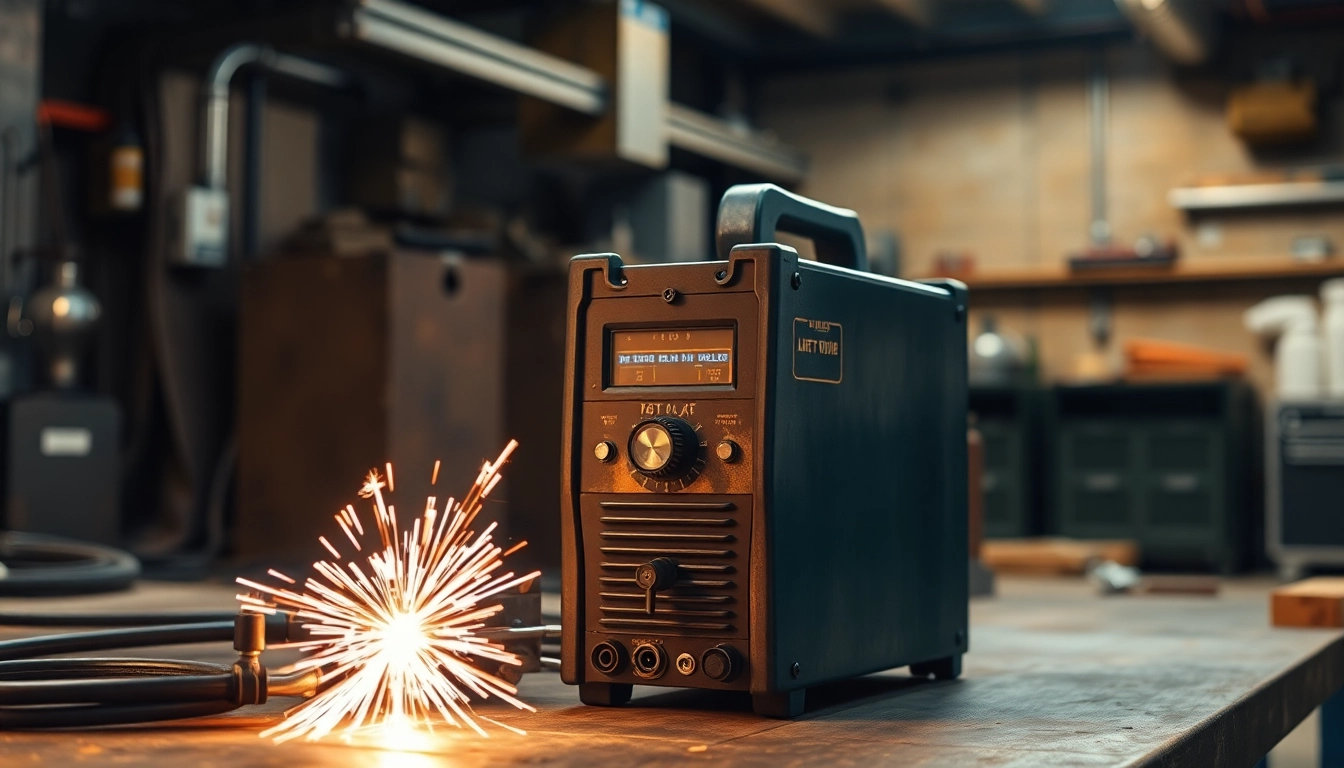Understanding AC DC TIG Welders
When it comes to welding processes, few methods rival the versatility and precision of Tungsten Inert Gas (TIG) welding, particularly when using an ac dc tig welder. This type of welder, capable of operating on both alternating current (AC) and direct current (DC), provides welders with immense flexibility to join various metals effectively. In this article, we will delve into the workings of AC DC TIG welders, their benefits, how to choose the right one, setup and usage techniques, as well as advanced applications and maintenance tips.
What is an AC DC TIG Welder?
An AC DC TIG welder is a type of welding machine that can utilize both alternating and direct current to produce high-quality welds. This capability allows the welder to work on a diverse range of materials, including aluminum, stainless steel, and other non-ferrous metals. AC welders are particularly effective on aluminum and magnesium, where they deliver cleaner welds without causing distortion, while DC welders are preferred for steels and non-ferrous metals for their consistent arc stability.
Differences Between AC and DC Welding
The fundamental differences between AC and DC welding lie primarily in the direction of the electrical current:
- Alternating Current (AC): AC welding works by reversing the current flow periodically, which is advantageous for cleaning oxidation off the surface of aluminum and providing a brighter arc. AC is most effective for working with materials that require heat and cleaning action to ensure a strong bond.
- Direct Current (DC): DC welding maintains a constant flow of electricity, which is ideal for welding ferrous metals, such as steel. It provides a more stable and controllable arc, making it preferable for applications requiring precision and control, such as overhead welding.
Benefits of Using AC DC TIG Welders
The incorporation of both AC and DC capabilities in a single machine provides several advantages:
- Versatility: Welders can adjust settings to suit different materials and thickness, maximizing welding options and applications.
- High-Quality Welds: TIG welding provides clean, precise welds with minimal spatter, suitable for high-quality fabrication and thin materials.
- Stability and Control: The ability to control heat input helps prevent warping and other defects, ensuring consistent results.
- Power Efficiency: AC DC TIG welders tend to be energy-efficient, making them cost-effective for both hobbyists and professionals.
Choosing the Right AC DC TIG Welder
Selecting the proper AC DC TIG welder can significantly impact the type and quality of welding performed. To make an informed choice, it’s essential to consider several key factors.
Top Features to Look For
- Amperage Range: Look for a welder with a wide amperage range to accommodate different material thicknesses.
- Portability: If you plan to move your welder around, consider the weight and design for ease of transportation.
- Duty Cycle: A higher duty cycle allows for longer periods of operation without overheating, ensuring that jobs can be completed without downtime.
- Control Features: Advanced models offer digital displays, programmable settings, and precision controls for enhanced user experience.
- Cooling System: Effective cooling mechanisms will prolong the life of the machine by regulating temperature during operation.
Recommended Brands and Models
Several brands excel in the production of high-quality AC DC TIG welders, each offering various models to meet diverse needs:
- Lincoln Electric: Known for reliability, the Lincoln Electric Aspect 230 is a great choice for both amateur and professional welders.
- Miller Electric: The Miller Syncrowave series provides excellent welding performance for heavy industrial applications.
- Everlast: Well-regarded for affordability, Everlast offers robust models like the PowerTIG series suitable for beginners and pros alike.
- PrimeWeld: Their TIG225X model is known for ease of use and a solid entry point into TIG welding.
Budget Considerations
Prices for AC DC TIG welders can vary significantly based on features and brand reputation. Here’s how to approach budgeting:
- Entry-Level Models: These usually range from $500 to $1000 and are suitable for hobbyists or light use.
- Mid-Range Models: Ranging from $1000 to $3000, these machines are ideal for serious weekend welders or semi-professionals.
- Professional Models: High-end machines cost over $3000, tailored for heavy industrial use with advanced features for precision and reliability.
Setting Up Your AC DC TIG Welder
Proper setup is crucial for ensuring optimal performance and safety during welding. Follow this comprehensive setup guide to get your AC DC TIG welder ready for action.
Preparing Your Workspace
Your welding workspace should be clean, spacious, and free from combustible materials. Ensure that adequate ventilation is in place, particularly when working with aluminum, which can generate harmful fumes. Keep all tools and materials organized to streamline your workflow.
Essential Equipment and Safety Gear
Alongside your welder, you will need other equipment and safety gear:
- Protective Clothing: Wear flame-resistant clothing to protect against sparks and heat.
- Welding Helmet: A proper helmet with a dark lens setting is essential for protecting your eyes from the bright arc.
- Gloves: Use insulated welding gloves for protection and improved grip.
- Filler Rods: Select the appropriate filler rod for the materials you are welding.
- Argon Gas Supply: Ensure you have a sufficient supply of argon gas, which is used as a shielding gas in TIG welding.
Step-by-Step Setup Guide
- Assemble Your Welder: Unpack your welder and connect the parts, ensuring all connections are secure.
- Connect Power Supply: Ensure the welder is plugged into a compatible power outlet with adequate voltage.
- Attach the Argon Cylinder: Securely connect the argon tank. Check for leaks before proceeding.
- Set Electrode and Filler Steel: Choose the correct tungsten electrode and filler rod based on your materials.
- Adjust Settings: Set your welder’s parameters according to the project’s requirements, including AC/DC selection, amperage, and gas flow rate.
- Test Run: Do a test weld on scrap material to assess settings before starting on your actual workpiece.
Basic Techniques for Using an AC DC TIG Welder
After setting up your welder, it’s essential to understand the basic techniques to achieve successful welds.
Getting Started with Welding
Begin by ensuring your workpiece is clean and free of unnecessary contaminants. Use a wire brush or grinding method to remove rust, paint, and oil. If needed, hold the tungsten at about a 15-20 degree angle to the workpiece for a better arc.
TIG Welding Techniques for Beginners
Here are some essential techniques to help you get started:
- Foot Pedal Control: Practice using the foot pedal to regulate current flow, especially when initiating the weld.
- Weaving Technique: For wider welds, practice moving your torch in a slight weaving pattern rather than a straight line.
- Control Distance: Maintain a consistent distance between the electrode and the workpiece, typically around 1/8 inch.
Common Mistakes to Avoid
Even experienced welders can face challenges. Here are some common pitfalls:
- Inconsistent Speed: This can lead to poor quality welds. Aim for a steady hand and consistent pace.
- Incorrect Settings: Adjusting the amperage incorrectly can either burn through thin metals or fail to penetrate thicker materials.
- Neglecting Safety: Always wear proper safety gear and ensure your workspace is safe to prevent accidents.
Advanced Techniques and Applications
Once you are comfortable with the basics, you can explore advanced techniques and applications of AC DC TIG welding.
Welding Different Metals with AC DC TIG
Understanding the characteristics of various metals is crucial for successful welding. Here’s how to approach different materials:
- Aluminum: Use AC welding with a higher cleaning action for best results. Keep the tungsten sharp and maintain correct torch angle.
- Stainless Steel: DC is preferred for stainless steel welding, providing greater control and a cleaner arc.
- Steel: Both AC and DC can be used, but DC is typically more effective for thicker pieces, ensuring adequate penetration.
TIG Welding for Creative Projects
TIG welding is not just limited to standard applications; it can also be used creatively:
- Artistic Fabrication: Sculptors often use TIG welding to join steel parts in artistic endeavors.
- Custom Motorcycle Frame Building: The precision of TIG welding allows for intricate designs and custom shapes.
- Metal Artwork: Whether it’s furniture design or standalone art pieces, TIG welding offers unique opportunities for artistic expression.
Maintaining Your AC DC TIG Welder
Regular maintenance will ensure your AC DC TIG welder operates at peak efficiency. Here are some essential tips:
- Clean Regularly: Ensure the machine is free of debris, especially around the fan and air vents.
- Check Consumables: Frequently inspect and replace worn tungsten electrodes and flow meters.
- Inspect Electrical Components: Periodically check all electrical connections and cords for signs of wear or damage.



